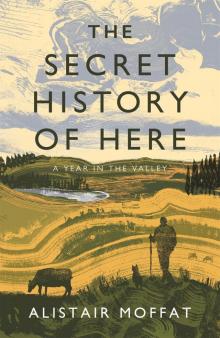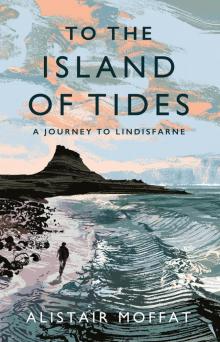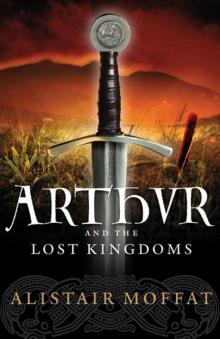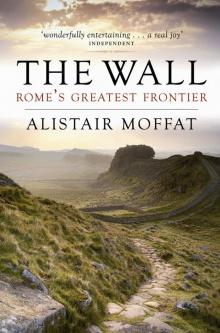- Home
- Alistair Moffat
Britain’s Last Frontier Page 20
Britain’s Last Frontier Read online
Page 20
In late 86, new orders arrived from Rome at the legionary fortress at Chester. Their garrison, the Legio II Adiutrix, was to be transferred immediately to Dacia, modern Romania, where a serious rebellion had flared up. That, in turn, meant the posting of the XX Valeria Victrix to the south as a replacement and, after only three years, Inchtuthil, much of it unfinished, was abandoned. Events moved fast. The completed timber buildings were stripped of anything useful and portable before being set alight. Pottery was methodically smashed into useless smithereens and carts and packhorses were quickly loaded. At the workshops, one centurion was faced with a problem. What should he do with the seven tons of valuable iron that had been beaten into the shape of nails? Perhaps because he had no spare transport capacity, perhaps because the legion was already moving out of the gates, he ordered a deep pit to be dug and the nails to be buried so that Caledonian smiths could not turn the iron into weapons. And, until Ian Richmond noticed a discolouration in the soil in 1961, the centurion’s decision was the right one.
After the nails were counted, dated and analysed and many of them distributed to interested parties such as other archaeologists, most of them were stored at the Dalzell Steel Mill in Motherwell. Eventually they were recycled as scrap iron and some people may now be driving around in a car made partly by legionary blacksmiths in Perthshire two thousand years ago. Atomic scientists also found a use for them in their calculations for the rate of corrosion for the cylinders used to contain nuclear waste. And, when the archaeologists first pulled these long and wickedly sharp nails out of the pit at Inchtuthil, it may have occurred to some that Roman soldiers had themselves found another use for them. If Christ was indeed nailed to the cross in Jerusalem then it was objects very like these that were hammered through his hands and feet.
No Rome
For almost the whole of the four centuries of the life of the province of Britannia, the Roman imperial government worried about what lay beyond the Highland Line. Agricola campaigned in the north for four years and appeared to defeat the Caledonian confederacy decisively at Mons Graupius. Hadrian and Antoninus Pius had expensive and massive walls built in part to keep the Highlanders out and Septimius Severus invaded with the largest army that ever crossed the Tweed. And yet the archaeological record of Roman artefacts found in the Highlands is so sparse as to be almost invisible. South of the Forth, a great deal has been found but north of the Tay comparatively little. This may be linked to the accident of discovery but that could apply anywhere and it compares very strangely with Rome’s European neighbours. The Baltic coastal region of Poland, what used to be East Prussia, lay far from the imperial frontier along the Rhine and Danube and was never invaded by the legions. And yet many more Roman items have been found there than have ever turned up in the Highlands. This may mean a conscious cultural rejection of what must have been seen as luxury goods or, at the very least, a lack of contact across the Highland Line – a very early example of a recurring theme.
Long after the fall of the Western Empire, the ghosts of long-dead Romans swirled around the Perthshire hills. At the foot of Glen Lyon, Fortingall is the home of a famous tree, a yew that has survived for more than 3,000 winters and is the oldest living thing in Europe. And lingering under its ancient shade are shadows of one of the most notorious Romans of them all, an imperial prefect who washed his hands at a turning point in the history of the world. A curiously persistent legend insists that Pontius Pilate was born at Fortingall, the son of Roman soldier and a Caledonian princess. It is of course chronologically impossible, for Pilate was in fact born around 15 BC, probably in the Abruzzo in Italy, and Rome did not penetrate the woods and the glens of Perthshire until the 1st century AD, in the late 70s. Perhaps the answer lies in a tradition of sanctity by association.
Fortingall stands on the site of a very early Christian church founded from Iona in the 8th century and it may be that its priests confected a spurious link to Christ. The fact that St Andrew knew Jesus and followed him is what made his cult and relics so powerful and his church at St Andrews so venerated. The same is true for the shrine at Santiago de Compostela in Northern Spain. And in Germany and elsewhere in Spain there are villages that claim Pontius Pilate. The fact that he effectively condemned Christ to death was less important than the fact that he had seen him, talked to him and been in his divine presence. The glow of Joseph of Arimathea, who had begged Pilate for Christ’s body, had the same value for the church at Glastonbury.
Roman soldiers probably did foray deep into the Highlands as far as Fortingall and Glen Lyon but not in 15 BC. They will have come from Inchtuthil, the momentary but massive presence of a mighty empire on the Highland Line. Perhaps that memory of Rome was enough to plant the seeds of legend around the ancient yew tree.
11
The Hill of Faith
IN THE DARKENING days of November 1950, a conspiracy was forming in the mind of a young man at Glasgow University. A great crime was to be committed – something that would scandalise one nation and delight another – and, after 650 years, a historical wrong would be righted.
Having completed his national service with the RAF, Ian Hamilton was 25, a little older than most students but no less idealistic. He joined the Scottish Covenant Association, a forerunner of the Scottish National Party, and became actively involved in pursuit of its principal goal, the achievement of independence. This was by no means unrealistic for, in 1948, more than two million Scots had signed the Scottish Covenant and Glasgow University was widely seen as an intellectual cradle of nationalism. With a clear understanding of the power of symbols and the impact of publicity, Hamilton’s idealism was hardening into determination and circling the notion of sensational coup. He would remove the Stone of Destiny from Westminster Abbey and return it to Scotland – where it belonged.
At the Mitchell Library, Hamilton began his research. The Stone of Destiny, also known as the Stone of Scone, had been used at the coronations of Scottish kings for many centuries. The last to sit on it had been King John I, crowned in 1292 after having been chosen by Edward I of England from amongst a number of claimants. Four years later John I became John Balliol once again when Edward stripped him of his kingdom and humiliated him publicly. ‘A man does good business when he rids himself of a turd,’ the English king is reported to have said when the royal coat of arms was ripped off Balliol’s tabard at a ceremony in Montrose. And so that none of the rival claimants could seize the empty throne and have themselves crowned on the Stone of Destiny, Edward had it removed from Scone Abbey and shipped to Westminster. There, it joined the looted relics and regalia of both Wales and Scotland.
Ian Hamilton’s researches related not only history but also valuable information about furniture. Edward had the Stone built into a coronation throne – what became known as the Confessor’s Chair. It was used for the coronation of English kings and, as they lowered their backsides on to it, it symbolised their claim to be Lords Paramount of Scotland, the feudal superior of all Scottish kings. For Hamilton it symbolised the domination of Scotland by England.
If the Stone was to be removed – not stolen for it was Edward I who was a thief – from Westminster Abbey, it would need to be broken out of the Confessor’s Chair and carried to a waiting vehicle. At three to four hundredweight, the Stone was heavy but masons had fitted two iron rings and, if these were somehow threaded through a stout metal bar or pipe, at least two strong men would be able to carry it. Clearly his researches told Hamilton that he would need at least one accomplice. Bill Craig was the President of the Glasgow University Union, a Liberal supporter but someone with an appetite for adventure. Or so Hamilton believed.
The next approach was perhaps more awkward. As a humble law student, Ian Hamilton had very little money and, for this bold enterprise to go forward, he needed funds. The Chairman of the Scottish Covenant Association and also Rector of Glasgow University at the time was John MacCormick. With what appeared to Hamilton to be a twinkle in his eye, the Lord Rector gave the p
enniless student £50 and asked to be kept discreetly informed.
Most urgent was a proper recce of Westminster Abbey and, with the cash, Hamilton immediately bought a train ticket to London. Posing as a tourist, he bought a good guide to the abbey, examined the Confessor’s Chair carefully and discovered the dimensions of the Stone (but not its weight). He then worked out a route out of the abbey to a place where a car might safely wait and then quickly get away. Through casual conversation with staff, Hamilton found out that no cleaners came in after the abbey closed to the public and that the nightwatchman’s office was not close to the Confessor’s Chapel and the Stone. That all strongly suggested a night raid. And the best plan was probably for Hamilton to hide in the abbey until it closed at 6 p.m., wait until the nightwatchman had finished his rounds at 2 a.m., then move to break the Stone out of the chair and remove it.
Plans began to take on the characteristics of crime fiction when the young student conceived the idea of two getaway cars. One would carry the Stone south-west out of London as far as lonely Dartmoor where it would be buried in a secret location until the hue and cry had died down. Then it would be repatriated to Scotland. A second car would make a decoy run to Wales to give the pursuing police the idea that the Stone would be handed over to Welsh Nationalists – for some reason.
The plans shifted from fiction to farce when Hamilton told Bill Craig that the best time to raid Westminster Abbey would be Christmas. In 1950, the Scots celebrated New Year rather than Christmas and the latter was seen very much as an English festival. Everyone in London would be focused on the celebrations, argued Hamilton, and distracted. Security at the abbey might be more lax and police pursuit less prompt and less enthusiastic since many officers would be on holiday. Sorry, said Craig, I’m too busy, too many social engagements I can’t break. And then there were the celebrations for the 500th anniversary of the founding of Glasgow University on 7 January and, as President of the Union, Craig had to make preparations for those. Sorry.
Hamilton was furious, depressed but still determined. Glasgow University traditionally marks the end of the winter or Martinmas term with Daft Friday. It fell on 15 December in 1950 and Hamilton invited a young teacher to be his partner at the evening dance. Like him, Kay Matheson was involved in the Scottish Covenant movement and, as a Gaelic speaker from Inverasdale in Wester Ross, she was a fervent nationalist. ‘I’m going to London to bring back the Stone of Destiny,’ announced Hamilton. After enquiring how much he had had to drink, Matheson agreed to come along. She would never be able to help lift the Stone but she could drive. More conspirators were needed.
Desperate for at least one more recruit and knowing that secrecy was vital, Hamilton despaired when three fellow students turned him down. But, when Gavin Vernon, a 24-year-old engineering undergraduate, counted himself in, the raiding party was complete. Hamilton collected together a burglar’s toolkit including a long and heavy jemmy of which he was very proud. Arrangements were made to hire a car.
When the three conspirators met at the garage in Pitt Street in Glasgow to collect the vehicles, they were crestfallen to discover that it was a 1938 Ford with a small engine and no heater. A winter journey from Glasgow to London in a slow and draughty car would chill their bones. When Hamilton emerged from the garage, he saw Gavin Vernon talking to another student, clearly telling him about the trip. He knew that various friends had been informed and sworn to secrecy – but who was this? Alan Stuart was very keen to join the gang and he overcame Hamilton’s initial reluctance when he told him that he had a car, a Ford Anglia. The original getaway plan could now work.
It was a difficult, dangerous journey as winter weather quickly closed in. Over the Pennines from Carlisle to Scotch Corner, the cars skidded, the unheatedwindscreens iced up repeatedly and they had to be scraped clear with nothing better than fingernails. But, in late December 1950, there was very little traffic. There were also nomotorways or bypasses, and although itwas a trunk road, like the A1, it passed through the centres of all the towns and cities on its route south. Long-distance journeys were still undertaken by train.
When London was at last reached, they split into two groups. In the late afternoon of 23 December, Vernon and Hamilton entered Westminster Abbey as visitors. Under a cleaner’s trolley, Hamilton hid himself, pulling his coat over his head, while Vernon left at closing time to take up his position outside. They waited. But not for long.
‘What the devil are you doing here? A nightwatchman shone a torch in Hamilton’s face and waited for an explanation. The young student improvised brilliantly, claiming he had inadvertently been shut in. And amazingly he was not detained while a call was put through to the police. In fact, the friendly nightwatchman escorted him to the main door with a kind word and a ‘Merry Christmas!’
When the group reconvened, holding a cold council of war in the Ford Anglia, they were not deterred. Indeed, Kay Matheson appeared more determined than ever, ignoring Hamilton’s embarrassment at being caught so easily. They would break in from the outside, take the Stone, manhandle it into the cars and they would speed away to Dartmoor and Wales as planned.
It was late on Christmas Eve. London’s streets were buzzing with groups of revellers and late shoppers and the lights of pubs and restaurants twinkled as four young Scots made their way to Westminster Abbey. Using their jemmy, Hamilton, Vernon and Stuart broke open one of the side doors. No torchlight swept the darkened abbey, no nightwatchman seemed to be on patrol and the students crept towards the Confessor’s Chapel. And there it was, under the seat of the Coronation Chair – the Stone of Destiny.
Once they had prised it out of its housing, cracking and splintering the ancient wood, the three young men were forced to put the Stone down immediately. It was tremendously heavy, much heavier than anyone imagined. And, when Ian Hamilton pulled hard on one the rings attached to the sides, it seemed to split into two pieces. The gang was aghast. But it must already have been cracked. When was it last moved? Centuries ago? Hamilton lifted the smaller piece, about a quarter of the whole, and staggered out of the door at Poets’ Corner. Kay Matheson backed up the Ford Anglia and the large fragment was bundled into the back seats.
Meanwhile the other two had used Hamilton’s overcoat as a kind of sling and then a sledge to drag the main part of the Stone across the floor of the nave. Kay Matheson was waiting outside but when Hamilton ran over to the car, she told him that a policeman had seen her and was coming across the road. Thinking quickly, Hamilton got into the front passenger seat and threw Alan Stuart’s coat over the Stone. When the policeman arrived, enquired and pointed out that it was 5 a.m., the student and the teacher pretended to be a couple down from Scotland. They hadn’t been able to find a room and were reluctantly spending the night shivering in their car. The policeman relaxed, took off his helmet and put it on the roof of the car, lit a cigarette and began chatting. Behind them, Hamilton could hear Vernon and Stuart dragging the Stone out of the abbey only a few yards away. Arrest was surely imminent. Matheson and he ‘engaged the constable in furious conversation’ until the other two saw him promptly and hid.
Once the coast was finally clear, Hamilton sent Kay Matheson off with the Ford Anglia and the fragment. She had a friend in the Midlands and would try to make it there. Now Hamilton would bring the second car round to the abbey and get the main part of the Stone away out of London and down to Dartmoor and safety. He put his hands in his pockets. No car keys. Not in any pocket. In all the excitements and exertions, the keys had been lost. Disaster. Worse than arrest, the Stone abandoned in the doorway of the abbey.
Kay Matheson, meanwhile, stopped at traffic lights in Knightsbridge. When they changed to green and she moved away, the boot of the Ford Anglia sprang open and the fragment of the Stone of Destiny fell out on to the road. She heard the crash, backed up the car and, with every ounce of her strength, somehow heaved it back in.
Instead of keys, Hamilton had found a box of matches and he began searching for them in the black
darkness. They had definitely been in the pocket of the overcoat used to drag the Stone but must have fallen out. Lighting matches as he went, the young man retraced his steps. And, near the abbey door, he stood on something hard – the keys.
After bundling the Stone into the 12-year-old Ford, Hamilton and Stuart drove south-east rather than south-west, having become lost in the suburbs of London. Vernon had left them and agreed to rendezvous after the Stone had been safely hidden somewhere in the English countryside. Jubilant that they had managed to remove the Stone of Destiny from Westminster Abbey but with little idea of where they were, the two students drove out of London and deeper into rural Kent. Desperate to find a hiding-place, they passed a large roadhouse built in a mock-Tudor style and two miles beyond that landmark (one they had to remember), they concealed the Stone in a ditch. It would do for the moment.
Hamilton and Stuart drove back to London and telephoned Bill Craig in Scotland. The story of the raid on the abbey was everywhere, all over the papers and, on the radio, Christmas programmes were interrupted with the sensational news. Traffic on all roads leading across the border to Scotland was being stopped and searched by the police. Elated, Hamilton and Stuart later drove down to Kent to find a better hiding place for the most wanted object in Britain. Neither had any idea what had happened to Kay Matheson. At least none of the press and radio coverage had mentioned an arrest.

 The Secret History of Here
The Secret History of Here The Night Before Morning
The Night Before Morning To the Island of Tides
To the Island of Tides Arthur and the Lost Kingdoms
Arthur and the Lost Kingdoms Britain’s Last Frontier
Britain’s Last Frontier The Faded Map: The Lost Kingdoms of Scotland
The Faded Map: The Lost Kingdoms of Scotland The Wall
The Wall